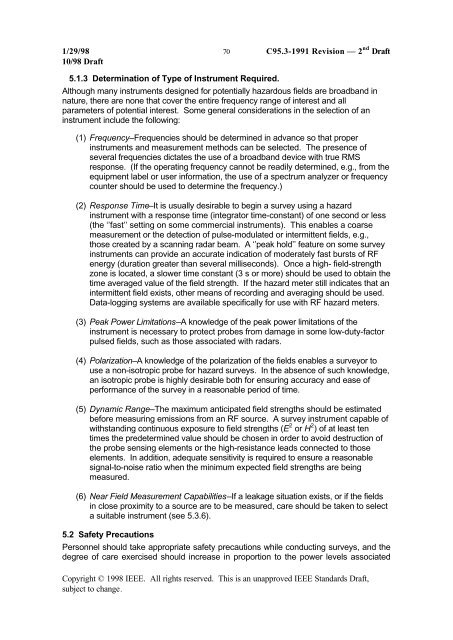DRAFT Recommended Practice for Measurements and ...
DRAFT Recommended Practice for Measurements and ...
DRAFT Recommended Practice for Measurements and ...
You also want an ePaper? Increase the reach of your titles
YUMPU automatically turns print PDFs into web optimized ePapers that Google loves.
1/29/98 70 C95.3-1991 Revision — 2 nd Draft<br />
10/98 Draft<br />
5.1.3 Determination of Type of Instrument Required.<br />
Although many instruments designed <strong>for</strong> potentially hazardous fields are broadb<strong>and</strong> in<br />
nature, there are none that cover the entire frequency range of interest <strong>and</strong> all<br />
parameters of potential interest. Some general considerations in the selection of an<br />
instrument include the following:<br />
(1) Frequency–Frequencies should be determined in advance so that proper<br />
instruments <strong>and</strong> measurement methods can be selected. The presence of<br />
several frequencies dictates the use of a broadb<strong>and</strong> device with true RMS<br />
response. (If the operating frequency cannot be readily determined, e.g., from the<br />
equipment label or user in<strong>for</strong>mation, the use of a spectrum analyzer or frequency<br />
counter should be used to determine the frequency.)<br />
(2) Response Time–It is usually desirable to begin a survey using a hazard<br />
instrument with a response time (integrator time-constant) of one second or less<br />
(the ‘’fast’’ setting on some commercial instruments). This enables a coarse<br />
measurement or the detection of pulse-modulated or intermittent fields, e.g.,<br />
those created by a scanning radar beam. A ‘’peak hold’’ feature on some survey<br />
instruments can provide an accurate indication of moderately fast bursts of RF<br />
energy (duration greater than several milliseconds). Once a high- field-strength<br />
zone is located, a slower time constant (3 s or more) should be used to obtain the<br />
time averaged value of the field strength. If the hazard meter still indicates that an<br />
intermittent field exists, other means of recording <strong>and</strong> averaging should be used.<br />
Data-logging systems are available specifically <strong>for</strong> use with RF hazard meters.<br />
(3) Peak Power Limitations–A knowledge of the peak power limitations of the<br />
instrument is necessary to protect probes from damage in some low-duty-factor<br />
pulsed fields, such as those associated with radars.<br />
(4) Polarization–A knowledge of the polarization of the fields enables a surveyor to<br />
use a non-isotropic probe <strong>for</strong> hazard surveys. In the absence of such knowledge,<br />
an isotropic probe is highly desirable both <strong>for</strong> ensuring accuracy <strong>and</strong> ease of<br />
per<strong>for</strong>mance of the survey in a reasonable period of time.<br />
(5) Dynamic Range–The maximum anticipated field strengths should be estimated<br />
be<strong>for</strong>e measuring emissions from an RF source. A survey instrument capable of<br />
withst<strong>and</strong>ing continuous exposure to field strengths (E 2 or H 2 ) of at least ten<br />
times the predetermined value should be chosen in order to avoid destruction of<br />
the probe sensing elements or the high-resistance leads connected to those<br />
elements. In addition, adequate sensitivity is required to ensure a reasonable<br />
signal-to-noise ratio when the minimum expected field strengths are being<br />
measured.<br />
(6) Near Field Measurement Capabilities–If a leakage situation exists, or if the fields<br />
in close proximity to a source are to be measured, care should be taken to select<br />
a suitable instrument (see 5.3.6).<br />
5.2 Safety Precautions<br />
Personnel should take appropriate safety precautions while conducting surveys, <strong>and</strong> the<br />
degree of care exercised should increase in proportion to the power levels associated<br />
Copyright © 1998 IEEE. All rights reserved. This is an unapproved IEEE St<strong>and</strong>ards Draft,<br />
subject to change.
















